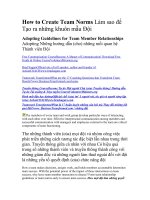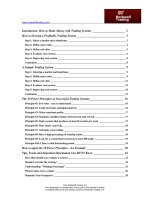Tài liệu How to organize your thesis pdf
Bạn đang xem bản rút gọn của tài liệu. Xem và tải ngay bản đầy đủ của tài liệu tại đây (99.58 KB, 7 trang )
How to Organize your Thesis
Prof. John W. Chinneck
Dept. of Systems and Computer Engineering
Carleton University
Ottawa, Canada
email: chinneck at sce dot carleton dot ca
Latest Revision: September 29, 1999
(original document dates to 1988, and undergoes periodic minor revisions)
Home for this document is:
Translations into other languages are available.
Introduction
This note describes how to organize the written thesis which is the central element of
your graduate degree. To know how to organize the thesis document, you first have to
understand what graduate-level research is all about, so that is covered too. In other
words, this note should be helpful when you are just getting started in your graduate
program, as well as later when you start to write your thesis.
What Graduate Research is All About
The distinguishing mark of graduate research is an original contribution to knowledge.
The thesis is a formal document whose sole purpose is to prove that you have made an
original contribution to knowledge. Failure to prove that you have made such a
contribution generally leads to failure.
To this end, your thesis must show two important things:
• you have identified a worthwhile problem or question which has not been
previously answered,
• you have solved the problem or answered the question.
Your contribution to knowledge generally lies in your solution or answer.
What the Graduate Thesis is All About
Because the purpose of the graduate thesis is to prove that you have made an original and
useful contribution to knowledge, the examiners read your thesis to find the answers to
the following questions:
• what is this student's research question?
• is it a good question? (has it been answered before? is it a useful question to work
on?)
• did the student convince me that the question was adequately answered?
• has the student made an adequate contribution to knowledge?
A very clear statement of the question is essential to proving that you have made an
original and worthwhile contribution to knowledge. To prove the originality and value of
your contribution, you must present a thorough review of the existing literature on the
subject, and on closely related subjects. Then, by making direct reference to your
literature review, you must demonstrate that your question (a) has not been previously
answered, and (b) is worth answering. Describing how you answered the question is
usually easier to write about, since you have been intimately involved in the details over
the course of your graduate work.
If your thesis does not provide adequate answers to the few questions listed above, you
will likely be faced with a requirement for major revisions or you may fail your thesis
defence outright. For this reason, the generic thesis skeleton given below is designed to
highlight the answers to those questions with appropriate thesis organization and section
titles. The generic thesis skeleton can be used for any thesis. While some professors may
prefer a different organization, the essential elements in any thesis will be the same.
Some further notes follow the skeleton.
Always remember that a thesis is a formal document: every item must be in the
appropriate place, and repetition of material in different places should be eliminated.
A Generic Thesis Skeleton
1. Introduction
This is a general introduction to what the thesis is all about it is not just a description
of the contents of each section. Briefly summarize the question (you will be stating the
question in detail later), some of the reasons why it is a worthwhile question, and perhaps
give an overview of your main results. This is a birds-eye view of the answers to the main
questions answered in the thesis (see above).
2. Background Information (optional)
A brief section giving background information may be necessary, especially if your work
spans two or more traditional fields. That means that your readers may not have any
experience with some of the material needed to follow your thesis, so you need to give it
to them. A different title than that given above is usually better; e.g., "A Brief Review of
Frammis Algebra."
3. Review of the State of the Art
Here you review the state of the art relevant to your thesis. Again, a different title is
probably appropriate; e.g., "State of the Art in Zylon Algorithms." The idea is to present
(critical analysis comes a little bit later) the major ideas in the state of the art right up to,
but not including, your own personal brilliant ideas.
You organize this section by idea, and not by author or by publication. For example if
there have been three important main approaches to Zylon Algorithms to date, you might
organize subsections around these three approaches, if necessary:
3.1 Iterative Approximation of Zylons
3.2 Statistical Weighting of Zylons
3.3 Graph-Theoretic Approaches to Zylon Manipulation
4. Research Question or Problem Statement
Engineering theses tend to refer to a "problem" to be solved where other disciplines talk
in terms of a "question" to be answered. In either case, this section has three main parts:
1. a concise statement of the question that your thesis tackles
2. justification, by direct reference to section 3, that your question is previously
unanswered
3. discussion of why it is worthwhile to answer this question.
Item 2 above is where you analyze the information which you presented in Section 3. For
example, maybe your problem is to "develop a Zylon algorithm capable of handling very
large scale problems in reasonable time" (you would further describe what you mean by
"large scale" and "reasonable time" in the problem statement). Now in your analysis of
the state of the art you would show how each class of current approaches fails (i.e. can
handle only small problems, or takes too much time). In the last part of this section you
would explain why having a large-scale fast Zylon algorithm is useful; e.g., by describing
applications where it can be used.
Since this is one of the sections that the readers are definitely looking for, highlight it by
using the word "problem" or "question" in the title: e.g. "Research Question" or "Problem
Statement", or maybe something more specific such as "The Large-Scale Zylon
Algorithm Problem."
5. Describing How You Solved the Problem or Answered the Question
This part of the thesis is much more free-form. It may have one or several sections and
subsections. But it all has only one purpose: to convince the examiners that you answered
the question or solved the problem that you set for yourself in Section 4. So show what
you did that is relevant to answering the question or solving the problem: if there were
blind alleys and dead ends, do not include these, unless specifically relevant to the
demonstration that you answered the thesis question.
6. Conclusions
You generally cover three things in the Conclusions section, and each of these usually
merits a separate subsection:
1. Conclusions
2. Summary of Contributions
3. Future Research
Conclusions are not a rambling summary of the thesis: they are short, concise statements
of the inferences that you have made because of your work. It helps to organize these as
short numbered paragraphs, ordered from most to least important. All conclusions should
be directly related to the research question stated in Section 4. Examples:
1. The problem stated in Section 4 has been solved: as shown in Sections ? to ??,
an algorithm capable of handling large-scale Zylon problems in reasonable time
has been developed.
2. The principal mechanism needed in the improved Zylon algorithm is the
Grooty mechanism.
3. Etc.
The Summary of Contributions will be much sought and carefully read by the examiners.
Here you list the contributions of new knowledge that your thesis makes. Of course, the
thesis itself must substantiate any claims made here. There is often some overlap with the
Conclusions, but that's okay. Concise numbered paragraphs are again best. Organize from
most to least important. Examples:
1. Developed a much quicker algorithm for large-scale Zylon problems.
2. Demonstrated the first use of the Grooty mechanism for Zylon calculations.
3. Etc.
The Future Research subsection is included so that researchers picking up this work in
future have the benefit of the ideas that you generated while you were working on the
project. Again, concise numbered paragraphs are usually best.
7. References
The list of references is closely tied to the review of the state of the art given in section 3.
Most examiners scan your list of references looking for the important works in the field,
so make sure they are listed and referred to in section 3. Truth be known, most examiners
also look for their own publications if they are in the topic area of the thesis, so list these
too. Besides, reading your examiner's papers usually gives you a clue as to the type of
questions they are likely to ask.
All references given must be referred to in the main body of the thesis. Note the
difference from a Bibliography, which may include works that are not directly referenced
in the thesis. Organize the list of references either alphabetically by author surname
(preferred), or by order of citation in the thesis.
8. Appendices
What goes in the appendices? Any material which impedes the smooth development of
your presentation, but which is important to justify the results of a thesis. Generally it is
material that is of too nitty-gritty a level of detail for inclusion in the main body of the
thesis, but which should be available for perusal by the examiners to convince them
sufficiently. Examples include program listings, immense tables of data, lengthy
mathematical proofs or derivations, etc.
Comments on the Skeleton
Again, the thesis is a formal document designed to address the examiner's two main
questions. Sections 3 and 4 show that you have chosen a good problem, and section 5
shows that you solved it. Sections 1 and 2 lead the reader into the problem, and section 6
highlights the main knowledge generated by the whole exercise.
Note also that everything that others did is carefully separated from everything that you
did. Knowing who did what is important to the examiners. Section 4, the problem
statement, is the obvious dividing line. That's the main reason for putting it in the middle
in this formal document.
Getting Started
The best way to get started on your thesis is to prepare an extended outline. You begin by
making up the Table of Contents, listing each section and subsection that you propose to
include. For each section and subsection, write a brief point-form description of the
contents of that section. The entire outline might be 2 to 5 pages long. Now you and your
thesis supervisor should carefully review this outline: is there unnecessary material (i.e.
not directly related to the problem statement)? Then remove. Is there missing material?
Then add. It is much less painful and more time-efficient to make such decisions early,
during the outline phase, rather than after you've already done a lot of writing which has
to be thrown away.
How Long Does it Take to Write a Thesis?
Longer than you think. Even after the research itself is all done models built,
calculations complete it is wise to allow at least one complete term for writing the
thesis. It's not the physical act of typing that takes so long, it's the fact that writing the
thesis requires the complete organization of your arguments and results. It's during this
formalization of your results into a well-organized thesis document capable of
withstanding the scrutiny of expert examiners that you discover weaknesses. It's fixing
those weaknesses that takes time.
This is also probably the first time that your supervisor has seen the formal expression of
concepts that may have been approved previously in an informal manner. Now is when
you discover any misunderstandings or shortcomings in the informal agreements. It takes
time to fix these. Students for whom english is not the mother tongue may have difficulty
in getting ideas across, so that numerous revisions are required. And, truth be known,
supervisors are sometimes not quick at reviewing and returning drafts.
Bottom line: leave yourself enough time. A rush job has painful consequences at the
defence.
Tips
Always keep the reader's backgrounds in mind. Who is your audience? How much can
you reasonably expect them to know about the subject before picking up your thesis?
Usually they are pretty knowledgeable about the general problem, but they haven't been
intimately involved with the details over the last couple of years like you have: spell
difficult new concepts out clearly. It sometimes helps to mentally picture a real person
that you know who has the appropriate background, and to imagine that you are
explaining your ideas directly to that person.
Don't make the readers work too hard! This is fundamentally important. You know what
few questions the examiners need answers for (see above). Choose section titles and
wordings to clearly give them this information. The harder they have to work to ferret out
your problem, your defence of the problem, your answer to the problem, your
conclusions and contributions, the worse mood they will be in, and the more likely that
your thesis will need major revisions.
A corollary of the above: it's impossible to be too clear! Spell things out carefully,
highlight important parts by appropriate titles etc. There's a huge amount of information
in a thesis: make sure you direct the readers to the answers to the important questions.
Remember that a thesis is not a story: it usually doesn't follow the chronology of things
that you tried. It's a formal document designed to answer only a few major questions.
Avoid using phrases like "Clearly, this is the case " or "Obviously, it follows that ";
these imply that, if the readers don't understand, then they must be stupid. They might not
have understood because you explained it poorly.
Avoid red flags, claims (like "software is the most important part of a computer system")
that are really only your personal opinion and not substantiated by the literature or the
solution you have presented. Examiners like to pick on sentences like that and ask
questions like, "Can you demonstrate that software is the most important part of a
computer system?"
A Note on Computer Programs and Other Prototypes
The purpose of your thesis is to clearly document an original contribution to knowledge.
You may develop computer programs, prototypes, or other tools as a means of proving
your points, but remember, the thesis is not about the tool, it is about the contribution to
knowledge. Tools such as computer programs are fine and useful products, but you can't
get an advanced degree just for the tool. You must use the tool to demonstrate that you
have made an original contribution to knowledge; e.g., through its use, or ideas it
embodies.
Master's vs. PhD Thesis
There are different expectations for Master's theses and for Doctoral theses. This
difference is not in format but in the significance and level of discovery as evidenced by
the problem to be solved and the summary of contributions; a Doctoral thesis necessarily
requires a more difficult problem to be solved, and consequently more substantial
contributions.
The contribution to knowledge of a Master's thesis can be in the nature of an incremental
improvement in an area of knowledge, or the application of known techniques in a new
area. The Ph.D. must be a substantial and innovative contribution to knowledge.









